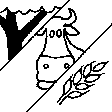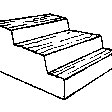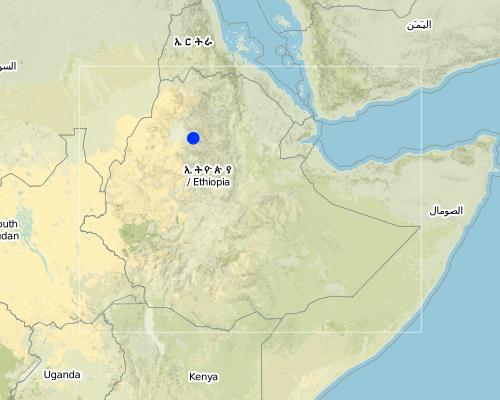Paved and grassed waterways [埃塞俄比亚]
- 创建:
- 更新:
- 编制者: Berhanu Fentaw
- 编辑者: –
- 审查者: Fabian Ottiger
Feses (Amharic)
technologies_1079 - 埃塞俄比亚
查看章节
全部展开 全部收起1. 一般信息
1.2 参与该技术评估和文件编制的资源人员和机构的联系方式
SLM专业人员:
Estifanos Zena
Ministry of Agriculture and Rural Development, Addis Ababa
Addis Ababa - Ethiopia
埃塞俄比亚
有助于对技术进行记录/评估的机构名称(如相关)
Ministry of Agriculture and Rural Development of Ethiopia (Ministry of Agriculture and Rural Development) - 埃塞俄比亚1.3 关于使用通过WOCAT记录的数据的条件
(现场)数据是什么时候汇编的?:
16/10/2005
编制者和关键资源人员接受有关使用通过WOCAT记录数据的条件。:
是
2. SLM技术的说明
2.1 技术简介
技术定义:
A waterway is an artficial drainage channel constructed along the steepest slope to receive runoff from cutoff drains and graded structures and drain to the natural waterway safely.
2.2 技术的详细说明
说明:
A vegetative waterway is constructed in areas where stone is not available and in gentle slopes. Paved waterways are suitable in steeper terrains and areas with large amount of stones. The waterway carries excess water to the river, reservoirs or gullies safely with out creating erosion. It is applicable in all areas where excess water is generated when high rains are received which are beyound the intake capacity of soils. The excess water then will have to be disposed sefely to natural outlets. Waterways are established a year or two before cutoff drains and field structures are constructed. Vegetative waterways are formed by digging earth channel across the contour in the direction of flow. After making the channel suitable grass species are planted or are made to establish naturally. Maintenance is very vital in waterways. Breaks in channel or embankments, moving of silt deposited or keeping the grass shorter in order that it does not obstract flow. Vegetative waterways could be stablized by planting short growing grasses, sodding or letting natural growth.
2.5 已应用该技术的、本评估所涵盖的国家/地区/地点
国家:
埃塞俄比亚
区域/州/省:
South Gonder
有关地点的进一步说明:
Genbegna, Ayiba, Megish
Map
×2.6 实施日期
如果不知道确切的年份,请说明大概的日期:
- 50多年前(传统)
2.7 技术介绍
详细说明该技术是如何引入的:
- 通过项目/外部干预
注释(项目类型等):
introduced and farmers experience
3. SLM技术的分类
3.1 该技术的主要目的
- 减少、预防、恢复土地退化
3.2 应用该技术的当前土地利用类型

农田
- 一年一作
主要农作物(经济作物及粮食作物):
Major food crop: teff

混合(作物/放牧/树木),包括农林
- 农林牧业
主要产品/服务:
Semi-nomadism / pastoralism: Yes
Selective felling of (semi-) natural forests: Yes
Plantation forestry: Yes
Forest products and services: fuelwood, grazing / browsing, protection against natural hazards
注释:
Major land use problems (compiler’s opinion): soil erosion, flooding, decline of production and productivity.
Major land use problems (land users’ perception): soil erosion, shortage of feed and fodder, low productivity.
3.3 有关土地利用的更多信息
该技术所应用土地的供水:
- 雨养
每年的生长季节数:
- 1
具体说明:
Longest growing period in days: 210 Longest growing period from month to month: May - Dec
3.4 该技术所属的SLM组
- 横坡措施
- 地表水管理(泉、河、湖、海)
3.5 技术传播
具体说明该技术的分布:
- 均匀地分布在一个区域
如果该技术均匀地分布在一个区域上,请注明覆盖的大致区域。:
- 10-100 平方千米
注释:
The technology is practiced in 34 Kebeles in the Woreda.
3.6 包含该技术的可持续土地管理措施

植物措施
- V2:草和多年生草本植物

结构措施
- S3:分级沟渠、渠道、水道
注释:
Main measures: vegetative measures, structural measures
Type of agronomic measures: early planting
Type of vegetative measures: aligned: -graded strips *<sup>3</sup>
3.7 该技术强调的主要土地退化类型

土壤水蚀
- Wg:冲沟侵蚀/沟蚀
注释:
Main type of degradation addressed: Wg: gully erosion / gullying
Secondary types of degradation addressed: Wg: gully erosion / gullying
3.8 防止、减少或恢复土地退化
具体数量名该技术与土地退化有关的目标:
- 减少土地退化
注释:
Secondary goals: prevention of land degradation, rehabilitation / reclamation of denuded land
4. 技术规范、实施活动、投入和成本
4.2 技术规范/技术图纸说明
Technical knowledge required for field staff / advisors: moderate
Technical knowledge required for land users: high
Main technical functions: control of concentrated runoff: drain / divert
Secondary technical functions: control of dispersed runoff: retain / trap, control of concentrated runoff: retain / trap
Early planting
Material/ species: grass
Remarks: aligment layout
Aligned: -graded strips
Vegetative material: G : grass
Grass species: local grass
Waterway
Depth of ditches/pits/dams (m): 0.3-0.4m
Width of ditches/pits/dams (m): 2-3m
Length of ditches/pits/dams (m): 50-100m
Construction material (stone): medium sized (big and small stones avoided)
Slope (which determines the spacing indicated above): 15%
If the original slope has changed as a result of the Technology, the slope today is: 15%
Lateral gradient along the structure: 20%
Other type of management: change of management / intensity level - controlling, maintaining and guarding.
4.3 有关投入和成本计算的一般信息
其它/国家货币(具体说明):
Birr
注明美元与当地货币的汇率(如相关):1美元=:
8.6
注明雇用劳工的每日平均工资成本:
0.80
4.4 技术建立活动
| 活动 | 措施类型 | 时间 | |
|---|---|---|---|
| 1. | determine the drainage area | 植物性的 | dry season |
| 2. | excavate and pile the soil on one or both side | 植物性的 | dry season |
| 3. | sods-local grass | 植物性的 | dry season |
| 4. | excavation and stone paving | 结构性的 | dry season |
| 5. | stone check | 结构性的 | dry season |
4.6 维护/经常性活动
| 活动 | 措施类型 | 时间/频率 | |
|---|---|---|---|
| 1. | Collecting planting materials | 农业学的 | beginning of rainy season / |
| 2. | Planting on pits | 农业学的 | rainy season / |
| 3. | resod-local grass | 植物性的 | after rain /once |
| 4. | repairing the broken part | 结构性的 | after ran/once |
| 5. | Collection of stones | 管理 | dry season / annual |
| 6. | Planting grass | 管理 | during rains / annual |
4.8 影响成本的最重要因素
描述影响成本的最决定性因素:
stone availability, finance, topography
5. 自然和人文环境
5.1 气候
年降雨量
- < 250毫米
- 251-500毫米
- 501-750毫米
- 751-1,000毫米
- 1,001-1,500毫米
- 1,501-2,000毫米
- 2,001-3,000毫米
- 3,001-4,000毫米
- > 4,000毫米
有关降雨的规范/注释:
It ranges between 1200-1599 mm
农业气候带
- 潮湿的
- 半湿润
Subhumid (ranked 1) in woina dega
Humid (ranked 2)
5.2 地形
平均坡度:
- 水平(0-2%)
- 缓降(3-5%)
- 平缓(6-10%)
- 滚坡(11-15%)
- 崎岖(16-30%)
- 陡峭(31-60%)
- 非常陡峭(>60%)
地形:
- 高原/平原
- 山脊
- 山坡
- 山地斜坡
- 麓坡
- 谷底
垂直分布带:
- 0-100 m a.s.l.
- 101-500 m a.s.l.
- 501-1,000 m a.s.l.
- 1,001-1,500 m a.s.l.
- 1,501-2,000 m a.s.l.
- 2,001-2,500 m a.s.l.
- 2,501-3,000 m a.s.l.
- 3,001-4,000 m a.s.l.
- > 4,000 m a.s.l.
关于地形的注释和进一步规范:
Altitudinal zone: Ranges between 1500-4033 m a.s.l.
Landforms: Mountain slopes (ranked 1), ridges (ranked 2) and plateau/plains as well as hill slopes (both ranked 3)
Slopes on average: Hilly (ranked 1), rolling (ranked 2) and steep (ranked 3)
5.3 土壤
平均土层深度:
- 非常浅(0-20厘米)
- 浅(21-50厘米)
- 中等深度(51-80厘米)
- 深(81-120厘米)
- 非常深(> 120厘米)
土壤质地(表土):
- 细粒/重质(粘土)
表土有机质:
- 低(<1%)
如有可能,附上完整的土壤描述或具体说明可用的信息,例如土壤类型、土壤酸碱度、阳离子交换能力、氮、盐度等。:
Soil depth on average: Very shallow (ranked 1), shallow (ranked 2) and moderately deep (ranked 3)
Soil texture: Fine/heavy ( on the top/surface, ranked 1) also medium (at depth , ranked 2) and coarse/light (ranked 3)
Soil fertility is low (ranked 1), medium (ranked 2) and high (ranked 3)
Soil drainage/infiltration is good (ranked 1), medium (ranked 2) and poor (ranked 3)
Soil water storage capacity is low (ranked 1), medium (ranked 2) and high (ranked 3)
5.6 应用该技术的土地使用者的特征
生产系统的市场定位:
- 生计(自给)
非农收入:
- 低于全部收入的10%
相对财富水平:
- 非常贫瘠
- 贫瘠
机械化水平:
- 手工作业
- 畜力牵引
说明土地使用者的其他有关特征:
Population density: 200-500 persons/km2
Annual population growth: 2% - 3%
40% of the land users are poor and own 20% of the land.
60% of the land users are poor and own 30% of the land.
Level of mechanization is animal traction (ranked 1) and manual labour (ranked 2)
Market orientation of production system: Also mixed (subsistence/ commercial)
5.7 应用该技术的土地使用者拥有或租用的平均土地面积
- < 0.5 公顷
- 0.5-1 公顷
- 1-2 公顷
- 2-5公顷
- 5-15公顷
- 15-50公顷
- 50-100公顷
- 100-500公顷
- 500-1,000公顷
- 1,000-10,000公顷
- > 10,000公顷
注释:
Average area of land owned or leased by land users applying the Technology: 0.5-0.75 ha
5.8 土地所有权、土地使用权和水使用权
土地所有权:
- 州
土地使用权:
- 个人
6. 影响和结论性说明
6.1 该技术的现场影响
社会经济效应
生产
作物生产
饲料生产
饲料质量
生产区域
收入和成本
农业收入
社会文化影响
SLM/土地退化知识
生态影响
水循环/径流
多余水的排放
土壤
土壤流失
其它生态影响
Soil fertility
6.2 该技术的场外影响已经显现
下游洪水
下游淤积
6.4 成本效益分析
技术收益与技术建立成本相比如何(从土地使用者的角度看)?
短期回报:
积极
长期回报:
非常积极
技术收益与技术维护成本/经常性成本相比如何(从土地使用者的角度看)?
短期回报:
积极
长期回报:
积极
6.5 技术采用
在所有采用这项技术的人当中,有多少人是自发地采用该技术,即未获得任何物质奖励/付款?:
- 90-100%
注释:
5 land user families have adopted the Technology without any external material support
Comments on spontaneous adoption: estimates
There is a moderate trend towards spontaneous adoption of the Technology
Comments on adoption trend: Waterways require high labour and material, which a poor farmer can not have. Moreover, the land taken by the measures will be prohibitive to be practiced by a smallholder farmers.
6.7 该技术的优点/长处/机会
| 编制者或其他关键资源人员认为的长处/优势/机会 |
|---|
|
due to increased benefit obtained by the community and awarness created How can they be sustained / enhanced? better/proper followup, maintenance, monitoring and evalution, expansion of the technology. Establish bylaws,regulations to protect assetes created. |
|
increased fodder production How can they be sustained / enhanced? provision of suitable planted material. |
链接和模块
全部展开 全部收起链接
无链接
模块
无模块


